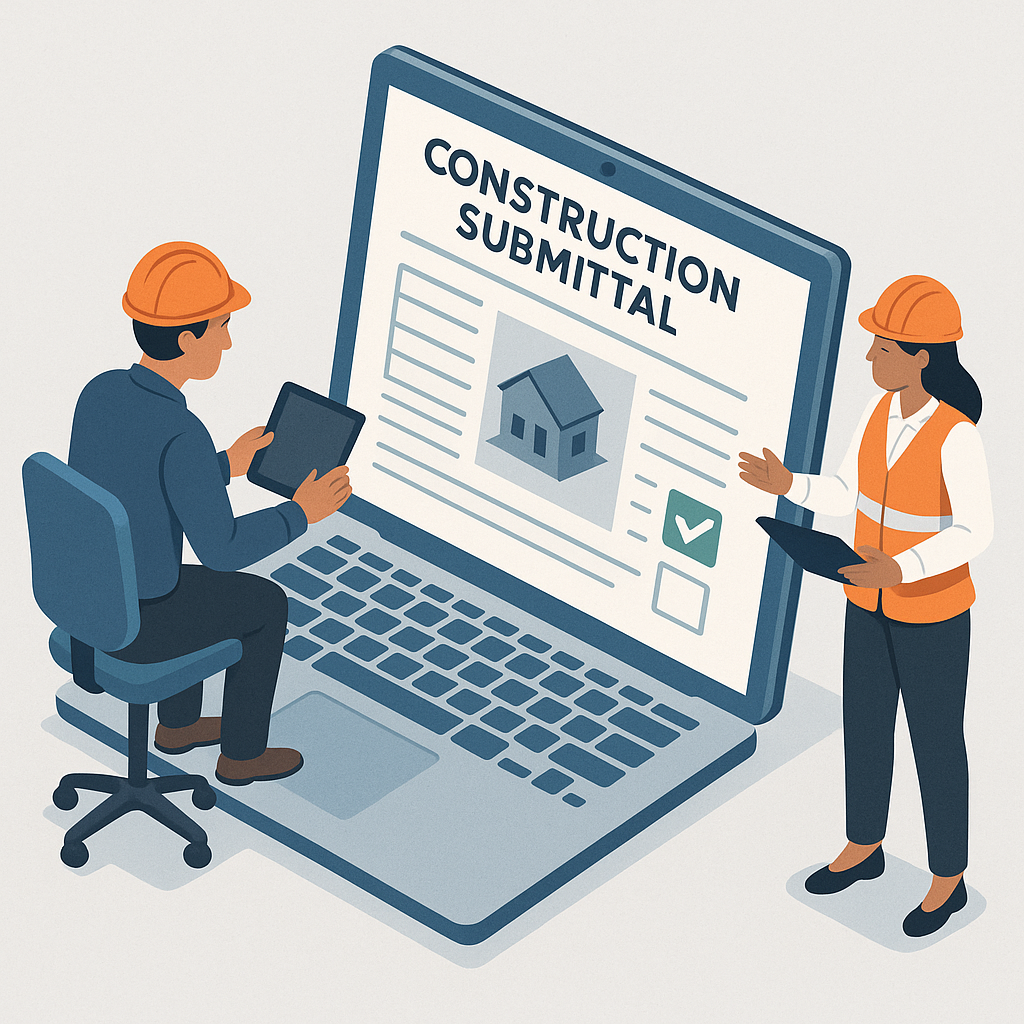.png)
TLDR; Quick list you can skim in 30 seconds:
- Project, area, and revision match
- Latest drawings/specs/RFIs/addenda used
- Correct spec section and required documents included
- Package completeness (every tag accounted for)
- Trade coordination and clash checks
- Code, ratings, and listings verified
- Electrical data aligned (voltage requirements, Energy Star rating, etc.)
- Dimensions, clearances, anchors, tolerances
- Right reviewers and stamps in the path
- Schedule, logistics, LEED and specific project requirements
Ever opened a shop drawing set and realized it was for the wrong project? Or the right project but last month’s revision? It happens. And it burns weeks. A one-minute triage up front keeps you from chasing fix-ups later. Below is a field-tested submittal review checklist you can put to work today. If you want an easier way to track and route all this, here’s our construction submittal software that bakes these checks into your workflow.

If you’re brand new to submittals, start here: What is a construction submittal?
1) Project, Area, and Revision Control
Check the title block and cover page against your IFC set. Confirm project name and number, building or zone, and the current revision. If you see carryover title-block info from a different project, stop and return for correction.
Pro tip: Keep a stamp or template note for “Revision/date mismatch. Reissue to current set.”
2) Latest Design Basis: Drawings, Specs, RFIs, Addenda, Bulletins
Submittals must reflect current information. Cross-check against recent addenda, bulletins, and RFIs. If the architect moved a wall or flipped a room layout, shops must show it. If not, pause review until the vendor updates.
3) Correct Spec Section and Submittal Type
Match the package to the CSI spec section. Confirm the required documents are all included: shop drawings, product data, test reports, listings, mockups, samples. If the spec asks for certifications or O&M, make sure they’re in the package or clearly identified as “to follow.”
4) Complete Package (No Missing Tags on Material Schedule)
Schedules need one-to-one tag coverage. For doors, equipment, fixtures, panels, anything tagged on the drawings, do a fast count. Every tag appears once in the submittal with the right data.
Example: Door & Hardware Package Completeness. Cross-check the contract door schedule against the shop schedule. Each door tag (D-301, D-302, etc.) appears once with frame type, hardware set, handing, finish, and rating if required.
5) Coordination With Other Trades
Look for interfaces and clashes: structure, MEP/FP/FA, envelope, ceilings, access, maintenance clearances.
Example: Duct OD plus insulation doesn’t fit under beams once lights and sprinkler mains are in. Catch it here, not after hangers go up.
Pro tip: Add a simple overlay habit. Even a quick PDF overlay of plan and section catches 80% of gotchas.
6) Code, Ratings, and Listings
Check fire ratings, acoustic and energy requirements, UL/FM/NFPA listings, seismic or wind criteria, ICC-ES reports, and local regulations.
Example: Spec calls for a 45-minute listed door assembly. A plain door leaf with intumescent isn’t a listed assembly. Ask for the full listing.
7) Electrical Characteristics (If Applicable)
Verify voltage and phase, FLA, MCA, MOP, SCCR, and short-circuit coordination with available fault current.
Example: Design shows 480V/3Ø, MCA 58A, MOP 70A, SCCR 65kA. If the submittal shows 208V/3Ø, hit pause and re-coordinate. Panel AIC and upstream devices must exceed available fault current.
8) Dimensions, Clearances, Tolerances, Anchoring
Confirm critical dimensions, mounting heights, embed locations, fastener compatibility, and slab or edge tolerances.
Example: Curtain wall anchor tolerance is tighter than the slab edge can hold. Either adjust tolerance or provide shim and plate details now.
Pro tip: Ask vendors to cloud any dimension that drives field work: hole patterns, anchor edge distances, RO sizes, and minimum service clearances.

9) Review Path and Responsible Reviewers
Make sure the right disciplines will stamp it. AOR, EOR, and MEP/FP as needed. Envelope, acoustics, or code consultants for special items.
Example: Rooftop equipment curb should see both structural and mechanical review. If it’s not routed to both, fix the path.
If you’re debating whether something is an RFI instead of a submittal, see RFI meaning in construction for when to ask a question vs submit for approval.
10) Schedule, Logistics, and Special Requirements (LEED/Energy/Owner)
Confirm lead times vs need dates and phasing. Check storage and handling requirements, warranty and O&M needs, and any LEED documentation like EPDs, VOC content, or source distance. Don’t wait until procurement is locked to find out the item is 20 weeks and your rough-in starts in six.
Real-World Examples You Can Copy
- Dimensions: A VAV box often needs 18 inches of straight duct upstream. Your ceiling layout only allows 10. Either re-route or use a low-loss elbow and document the impact.
- Finish and Rating: Spec 08 14 00 wants a Walnut 2 stain and a 45-minute listed assembly. The submittal shows a site-stained 20-minute door. Reject and request the listed assembly with correct finish.
- Electrical: Panel shows 60A/3P but the cut sheet says MOP 70A. Either upsize the breaker and conductors or request the factory option to bring MOP to 60. Note cost and schedule effects.
One-Minute Submittal Triage Checklist
- Project, area, revision match
- Current drawings, specs, RFIs, addenda referenced
- Correct spec section and required documents included
- All tags and items accounted for once
- Code, ratings, and listings in place
- Electrical data aligned with design and fault studies
- Critical dimensions, clearances, and anchors verified
- Proper reviewers in the path
- Lead times, LEED, and owner requirements covered
Want a spreadsheet version and transmittal sheet? Grab our free submittal log template.
Why this matters
Good submittal reviews don’t just “approve.” They prevent rework, change orders, blown inspections, and schedule slips. If you’d like a workflow that tracks completeness, auto-routes to the right reviewers, and nudges people when the ball is in their court, our construction submittal software can help.
If you want to go deeper on the overall flow, see construction submittal process (step-by-step). And if you’re balancing clarifications, our best RFI software in 2025 roundup might save you a few clicks.
FAQ: Submittal Reviews (Quick Answers)
What’s the goal of a construction submittal?
To verify that materials, products, and installations match the contract documents before fabrication or install, so the design team can approve or comment.
How is an RFI different from a submittal?
A submittal confirms compliance (shops, product data, listings). An RFI asks for clarification when documents are missing or conflicting and the answer may affect scope, cost, schedule, or safety.
Who needs to review a submittal?
At minimum, the contractor and the relevant design discipline (architect, structural, MEP/FP). Specialty items may also need envelope, acoustics, code, or commissioning review.
What should a door and hardware submittal include?
Door schedule with tags, frame types, hardware sets, finishes, ratings, handing, closer/hinge types, and any listed assembly numbers for rated openings.
What electrical data should I verify on equipment submittals?
Voltage and phase, FLA, MCA, MOP, SCCR, and coordination with available fault current (panel AIC and upstream devices).
When should I stop review and return without comments?
If the package uses the wrong project/revision, doesn’t reflect current addenda/RFIs, or is missing required sections (shops/product data/listings), send it back for correction first.
How do I handle long lead items?
Check lead times against need dates early. If procurement is tight, request partial/early approvals for long-lead components and document logistics, storage, and warranty requirements.
Book a quick 15-minute walkthrough and we’ll show you how to set up a clean submittal review path and catch issues earlier.
